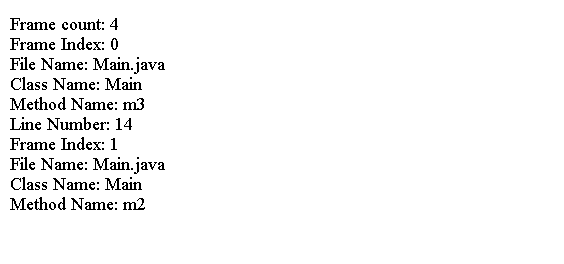Java 异常使用
Java面向对象的设计 - Java异常使用
访问线程的堆栈
以下代码显示了如何获取线程的堆栈帧。
Throwable对象在创建线程的点处捕获线程的堆栈。
public class Main {
public static void main(String[] args) {
m1();
}
public static void m1() {
m2();
}
public static void m2() {
m3();
}
public static void m3() {
Throwable t = new Throwable();
StackTraceElement[] frames = t.getStackTrace();
printStackDetails(frames);
}
public static void printStackDetails(StackTraceElement[] frames) {
System.out.println("Frame count: " + frames.length);
for (int i = 0; i < frames.length; i++) {
int frameIndex = i; // i = 0 means top frame
System.out.println("Frame Index: " + frameIndex);
System.out.println("File Name: " + frames[i].getFileName());
System.out.println("Class Name: " + frames[i].getClassName());
System.out.println("Method Name: " + frames[i].getMethodName());
System.out.println("Line Number: " + frames[i].getLineNumber());
}
}
}
上面的代码生成以下结果。

try-with-resources块
Java 7添加了一个名为try-with-resources的新结构。
使用Java 7中的新的try-with-resources构造,上面的代码可以写成
try (AnyResource aRes = create the resource...) {
// Work with the resource here.
// The resource will be closed automatically.
}
当程序退出构造时,try-with-resources构造自动关闭资源。
资源尝试构造可以具有一个或多个catch块和/或finally块。
我们可以在try-with-resources块中指定多个资源。两个资源必须用分号分隔。
最后一个资源不能后跟分号。
以下代码显示了try-with-resources使用一个和多个资源的一些用法:
try (AnyResource aRes1 = getResource1()) {
// Use aRes1 here
}
try (AnyResource aRes1 = getResource1(); AnyResource aRes2 = getResource2()) {
// Use aRes1 and aRes2 here
}
我们在try-with-resources中指定的资源是隐式最终的。
在try-with-resources中的资源必须是java.lang.AutoCloseable类型。
Java 7添加了AutoCloseable接口,它有一个close()方法。
当程序退出try-with-resources块时,将自动调用所有资源的close()方法。
在多个资源的情况下,按照指定资源的相反顺序调用close()方法。
class MyResource implements AutoCloseable {
public MyResource() {
System.out.println("Creating MyResource.");
}
@Override
public void close() {
System.out.println("Closing MyResource...");
}
}
public class Main {
public static void main(String[] args) {
try (MyResource mr = new MyResource();
MyResource mr2 = new MyResource()) {
}
}
}
上面的代码生成以下结果。

Multi-Catch块
Java 7增加了对多catch块的支持,以便在catch块中处理多种类型的异常。
我们可以在multi-catch块中指定多个异常类型。多个异常由竖线(|)分隔。
捕获三个异常:Exception1,Exception2和Exception3。
try {
// May throw Exception1, Exception2, or Exception3
}
catch (Exception1 | Exception2 | Exception3 e) {
// Handle Exception1, Exception2, and Exception3
}
在multi-catch块中,不允许有通过子类化相关的替代异常。
例如,不允许以下multi-catch块,因为Exception1和Exception2是Throwable的子类:
try {
// May throw Exception1, Exception2, or Exception3
}
catch (Exception1 | Exception2 | Throwable e) {
// Handle Exceptions here
}





更多建议: